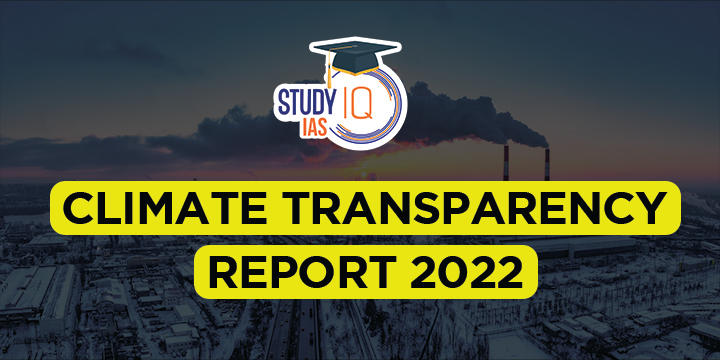Table of Contents
What is the Climate Transparency Report 2022
About: The Climate Transparency Report is the world’s most comprehensive annual review of G20 countries’ climate action and their transition to a net zero emissions economy.
Theme for the 2022 edition: G20 response to the energy crisis: Critical for 1.5°c.
Prepared by: The report was developed by experts from 16 partner organizations from the majority of the G20 countries.
Significance: The Climate Transparency Report 2022 report especially highlights the link between the climate emergency and energy crisis.
Climate Transparency Report 2022: Major Findings for India
- Emissions Overview
- Total emissions: India’s total greenhouse gas emissions (excluding LULUCF) have increased by 182% (1990–2019). The increases were largely due to a sustained increase in energy-related emissions.
- LULUCF stands for Land Use, Land-Use Change and Forestry.
- Per capita emissions: India’s per capita emissions (including LULUCF) are approximately 30% of the G20 average. Total per capita emissions have increased by 12% from 2014 to 2019.
- Methane emissions: India’s methane emissions (excl. LULUCF) increased by 10% between 1990–2019.
- The majority of India’s methane emissions came from the agriculture sector in 2019.
- Agricultural emissions: India has the largest cattle population in the world (38%) and agricultural emissions are primarily from the digestive processes and manure of livestock (mainly cattle).

- Energy Overview
- Fossil fuels: India’s energy mix was still dominated by fossil fuels (74%) in 2021, around 9% lower than the G20 average. Increased energy supply was mainly driven by increased coal from 1990–2010.
- Renewables: Solar, wind, geothermal and biomass, excluding traditional biomass, account for 11.6% of India’s energy supply – the G20 average is 7.5%.
- Carbon intensity of the energy sector: Carbon intensity is a measure of how much CO2 is emitted per unit of energy supply. Emissions intensity in India in 2021 was 58 tCO2/TJ, almost the same as the G20 average.
- Energy intensity of the economy: This indicator quantifies how much energy is used for each unit of GDP. India’s energy intensity is lower than the G20 average.

- Electricity Generation
- India is the third-largest producer of electricity after China and the US. India’s electricity generation is dominated by coal, around 72% in 2021.
- The share of renewable energy has increased around 29% in the last five years (2016–2021) to 20% (including domestic large hydro) of the power mix in 2021.

- Impacts of a Changing Climate
- Increased temperatures: Between 2017 to 2021, the average summer temperatures experienced by people in India were 0.4°C higher than the 1986–2005 average global mean temperature increase of 0.3°C.
- Income losses: India suffered an income loss of $159 billion, 5.4% of its gross domestic product, in the service, manufacturing, agriculture, and construction sectors due to extreme heat in 2021.
- Loss of labour productivity: Heat exposure in the country led to the loss of 167 billion potential labour hours, a 39% increase from 1990–1999.
- Losses due to extreme events: In 2020, India is estimated to have suffered an average annual loss of about USD 87bn from extreme weather events such as tropical cyclones, floods and droughts.
- Increased droughts: About 33% of India is drought prone and 50% of these areas face chronic drought. These droughts have not only intensified but also increased in frequency over the last few decades.
- Future Impacts at 1.5°C Warming and Higher
- Indian rice production could decrease by 10–30%, and maize production could drop by 25–70% with temperature increases in a range of 1°C–4°C.
- Precipitation is projected to increase by 6% from the reference period of 1986–2006, at 1.5°C of warming. Snowfall in India is expected to decrease under 1.5°C scenario by 13%.
- The annual damage from river flooding in the country is likely to increase by around 49% at 1.5°C of warming. The damage from cyclones will increase by 5.7%.
- Labour productivity in India is projected to decline by 5% from the 1986–2006 reference period if global temperatures increase by 1.5°C.


 Current Affairs 29th April 2024 for UPSC...
Current Affairs 29th April 2024 for UPSC...
 Towards Green Growth, Impact of Climate ...
Towards Green Growth, Impact of Climate ...
 Editorial of the day (29th Apr): Israel ...
Editorial of the day (29th Apr): Israel ...

















